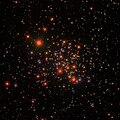Messier 67
| Messier 67 | |
|---|---|
ly[citation needed] | |
| Estimated age | 3.2 to 5 billion years |
| Other designations | NGC 2682, Cr 204 |
| Associations | |
| Constellation | Cancer |
Messier 67 (also known as M67 or NGC 2682) and sometimes called the King Cobra Cluster or the Golden Eye Cluster
Description
M67 is not the oldest known open cluster, but there are few Milky Way clusters known to be older, and none of those is closer than M67. It is a paradigm study object in stellar evolution:[6]
- it is well-populated
- has negligible amounts of dust obscuration
- all its stars are at the same distance and age, save for approximately 30 anomalous blue stragglers
M67 is one of the most-studied open clusters, yet estimates of its physical parameters such as age, mass, and number of stars of a given type, vary substantially. Richer
It has more than 100 stars similar to the Sun, and numerous red giants. The total star count has been estimated at well over 500.[9] The ages and prevalence of Sun-like stars had led some astronomers to theorize it as the possible parent cluster of the Sun.[10] However, computer simulations disagree on whether the outer Solar System would have survived an ejection from M67,[11][12] and the cluster itself would probably not have survived such an ejection event.[13]
The cluster contains no
It appears that M67 has a bias toward heavier stars. One cause of this is
A March 2016 joint
Planets
A radial velocity survey of M67 has found exoplanets around five stars in the cluster: YBP 1194, YBP 1514, YBP 401, Sand 978, and Sand 1429.[17][18][19][20] A sixth star, Sand 364, was also thought to have a planet, but a follow-up study did not find evidence for it and concluded that the radial velocity variations have a non-planetary origin, likely stellar variability.[21]
Gallery
-
Hertzsprung-Russell diagram for two open clusters, M67 and NGC 188, showing color-magnitude data
-
Artist's impression video showing a hot Jupiter exoplanet orbiting close to a star in Messier 67
-
Artist's impression of a hot Jupiter exoplanet in the star cluster Messier 67
See also
References
- ^ a b Paunzen, E.; Mermilliod, J.-C. "WEBDA page for open cluster NGC 2682". WEBDA. Retrieved 2022-10-12.
- ^ S2CID 11654120.
- ^ S2CID 1136371.
- ^ Bibcode:2011JAVSO..39..219M.
- ^ Martina McGovern. "M67 Open cluster". British Astronomical Association. Retrieved 2022-10-12.
- ^ Xiao-Bin Zhang; Rong-Xian Zhang & Zhi-Ping Li (2005). "S1280 and S1284: Two Oscillating Blue Stragglers in the Open Cluster M67". .
- ^
Harvey B. Richer; Gregory G. Fahlman; Joanne Rosvick; Rodrigo Ibata (1998). "The White Dwarf Cooling Age of M67". S2CID 17309096.
- ^
Jarrod R. Hurley; Onno R. Pols; Sverre J. Aarseth; Christopher A. Tout (2005). "A Complete N-body Model of the Old Open Cluster M67". S2CID 17632739.
- ^
W. L. Sanders (1977). "Membership of the open cluster M67". Bibcode:1977A&AS...27...89S.
- ^ "Did Our Solar System Originate in a Distant Star Cluster?". Daily Galaxy. 30 September 2014. Archived from the original on 10 May 2016. Retrieved 30 March 2016.
- .
- ^
Pichardo, Bárbara; Moreno, Edmundo; S2CID 119266159. article ID 73.
- .
- ^ Ch. Bonatto & E. Bica (2003). "Mass segregation in M67 with 2MASS" (PDF). .
- ^
Sydney A. Barnes; Jörg Weingrill; Dario Fritzewski; Klaus G. Strassmeier; Imants Platais (2016). "Rotation periods for cool stars in the 4 Gyr-old open cluster M67, the solar-stellar connection, and the applicability of gyrochronology to at least solar age". S2CID 89613927.
- ^ a b "Stars nearly as old as Sun found to have similar spin rates". Astronomy Now. 17 May 2016.
- .
- .
- .
- .
- .
External links
 Media related to Messier 67 at Wikimedia Commons
Media related to Messier 67 at Wikimedia Commons- Messier 67, SEDS Messier pages
- Merrifield, Mike. "M67 – Open Cluster". Deep Sky Videos. Brady Haran.
- Messier 67 on




